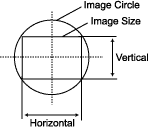
| Image Sensor | Image Circle | Horizontal | Vertical |
| 1/4" | Ø4.0mm | 3.2mm | 2.4mm |
| 1/3" | Ø6.0mm | 4.8mm | 3.6mm |
| 1/2" | Ø8.0mm | 6.4mm | 4.8mm |
| 2/3" | Ø11.0mm | 8.8mm | 6.6mm |
| 1" | Ø16.0mm | 12.8mm | 9.6mm |
 |

A lens produces images in the form of a circle, called the image circle. In a CCTV camera, the imaging element has a rectangular sensor area (the image size) that detects the image produced within the image circle. The ratio of the length of the horizontal to vertical sides of a video image is called the aspect ratio, which is normally 4:3 (H:V) for a standard CCTV camera.
An important factor to remember is that cameras with different image sensor chip sizes (such as 1/4", 1/3", 1/2", 2/3" and 1"), using the same focal length lens, will each yield a different field of view.
Lenses designed for a larger image sensor device will work on a new, smaller size camera. However, if a lens designed for a smaller format image sensor device (ie. 1/3") is placed on a larger one (ie. 2/3"), the image on the monitor will have dark corners.
Image sensor sizes are in a ratio of 1:0.69:0.5:0.38:0.25. This means that a 1/2" format is 50% of a 1" format, a 1/2" format is 75% of a 2/3" format and a 1/3" format is 75% of a 1/2" format.
Minimum object distance (M.O.D.) indicates how close the lens can be placed to the object for shooting. It is measured from the vertex of the front glass of the lens.
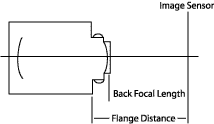 |
Distance between mechanical mount surface and the
image sensor (in air).
C-Mount=17.526 mm / .690"
CS-Mount=12.526 mm / .492"
Back Focal Length
Distance between vertex of the rear element lens and image sensor.
C-Mount and CS-Mount Lens Compatibility
| Compatibility | C-Mount Camera | CS-Mount Camera |
| C-Mount Lens | OK | OK |
| CS-Mount Lens | NO | OK |
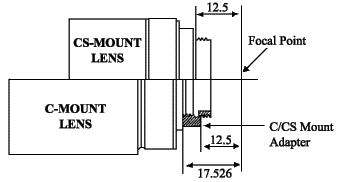 |
When using a C-mount lens for a CS-mount camera, a C/CS-mount adapter (5 mm thick) is required between the lens and the camera.
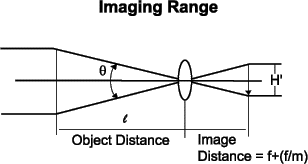 |
Angle of View
|
The angle of view is the shooting range that can be viewed by the lens given a specified image size. It is usually expressed in degrees. Normally the angle of view is measured assuming a lens is focused at infinity. The angle of view can be calculated if the focal length and image size are known. If the distance of the object is finite, the angle is not used. Instead, the dimension of the range that can actually be shot, or the field of view, is used.
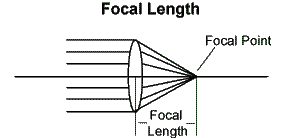 |
Parallel incident light transmitted into a convex lens converges to a point on the optical axis. This point is the focal point of the lens. The distance between the principle point in the optical system and the focal point is referred to as the focal length. For a single thin lens, the focal length is equal to the distance between the center of the lens and the focal point.
Zoom Ratio
Zoom ratio is the ratio of the focal
length at the telephoto end to that at the wide end. A zoom lens can change the
size of an object appearing on the monitor to the extent specified by the zoom
ratio